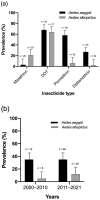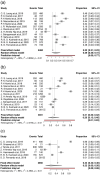Updating the Insecticide Resistance Status of Aedes aegypti and Aedes albopictus in Asia: A Systematic Review and Meta-Analysis
- PMID: 36288047
- PMCID: PMC9607256
- DOI: 10.3390/tropicalmed7100306
Updating the Insecticide Resistance Status of Aedes aegypti and Aedes albopictus in Asia: A Systematic Review and Meta-Analysis
Abstract
Background: Aedes aegypti and Aedes albopictus are two important vectors of several important arboviruses, including the dengue, chikungunya, and Zika viruses. Insecticide application is an important approach to reduce vector abundance during Aedes spp.-borne outbreaks in the absence of effective vaccines and treatments. However, insecticide overuse can result in the development of resistance, and careful monitoring of resistance markers is required.
Methods: This meta-analysis and systematic review explored the spatial and temporal patterns of insecticide resistance in Asia from 2000 to 2021. PubMed, Scopus, EbscoHost, and Embase were used to enhance the search capability. The random-effects model was applied for the 94 studies that met our inclusion criteria for qualitative synthesis and meta-analysis.
Results: Four major insecticides were studied (malathion, dichlorodiphenyltrichloroethane, permethrin, and deltamethrin). Dichlorodiphenyltrichloroethane resistance rates were high in both Ae. aegypti and Ae. albopictus (68% and 64%, respectively). Conversely, malathion resistance was less prevalent in Ae. aegypti (3%), and deltamethrin resistance was less common in Ae. albopictus (2%). Ae. aegypti displayed consistently high resistance rates (35%) throughout the study period, whereas the rate of insecticide resistance in Ae. albopictus increased from 5% to 12%. The rates of the major kdr mutations F1534C, V1016G, and S989P were 29%, 26%, and 22%, respectively.
Conclusions: Insecticide resistance in both Ae. aegypti and Ae. albopictus is widespread in Asia, although the rates vary by country. Continuous monitoring of the resistance markers and modification of the control strategies will be important for preventing unexpected outbreaks. This systematic review and meta-analysis provided up-to-date information on insecticide resistance in dengue-endemic countries in Asia.
Keywords: Aedes aegypti; Aedes albopictus; Asia; insecticide resistance; meta-analysis.
Conflict of interest statement
The authors declare no conflict of interest.
Figures







Similar articles
-
Temporal distribution and insecticide resistance profile of two major arbovirus vectors Aedes aegypti and Aedes albopictus in Yaoundé, the capital city of Cameroon.Parasit Vectors. 2017 Oct 10;10(1):469. doi: 10.1186/s13071-017-2408-x. Parasit Vectors. 2017. PMID: 29017606 Free PMC article.
-
Monitoring Aedes populations for arboviruses, Wolbachia, insecticide resistance and its mechanisms in various agroecosystems in Benin.Acta Trop. 2024 May;253:107178. doi: 10.1016/j.actatropica.2024.107178. Epub 2024 Mar 8. Acta Trop. 2024. PMID: 38461924
-
Spatial distribution of insecticide resistant populations of Aedes aegypti and Ae. albopictus and first detection of V410L mutation in Ae. aegypti from Cameroon.Infect Dis Poverty. 2022 Aug 17;11(1):90. doi: 10.1186/s40249-022-01013-8. Infect Dis Poverty. 2022. PMID: 35974351 Free PMC article.
-
Worldwide Status of Insecticide Resistance of Aedes aegypti and Ae. albopictus, Vectors of Arboviruses of Chikungunya, Dengue, Zika and Yellow Fever.J Arthropod Borne Dis. 2023 Mar 31;17(1):1-27. doi: 10.18502/jad.v17i1.13198. eCollection 2023 Mar. J Arthropod Borne Dis. 2023. PMID: 37609563 Free PMC article. Review.
-
A systematic review of insecticide resistance in Aedes aegypti (Diptera: Culicidae) and implications for dengue control in Indonesia.Vet World. 2025 Mar;18(3):658-672. doi: 10.14202/vetworld.2025.658-672. Epub 2025 Mar 18. Vet World. 2025. PMID: 40342756 Free PMC article. Review.
Cited by
-
Evaluation of Yellow Fever Virus Infection in Aedes aegypti Mosquitoes from Pakistan with Distinct Knockdown Resistance Genotypes.Insects. 2024 Dec 31;16(1):33. doi: 10.3390/insects16010033. Insects. 2024. PMID: 39859614 Free PMC article.
-
Beyond top-down: community co-creation approaches for sustainable dengue vector control.Glob Health Action. 2024 Dec 31;17(1):2426348. doi: 10.1080/16549716.2024.2426348. Epub 2024 Nov 8. Glob Health Action. 2024. PMID: 39514564 Free PMC article. Review.
-
Performance of two low-threshold population replacement gene drives in cage populations of the yellow fever mosquito, Aedes aegypti.PLoS Genet. 2025 Jun 26;21(6):e1011757. doi: 10.1371/journal.pgen.1011757. eCollection 2025 Jun. PLoS Genet. 2025. PMID: 40570069 Free PMC article.
-
Diversity and distribution of sodium channel mutations in Aedes albopictus (Diptera: Culicidae).J Med Entomol. 2024 May 13;61(3):630-643. doi: 10.1093/jme/tjae005. J Med Entomol. 2024. PMID: 38366894 Free PMC article.
-
Upsurge of dengue outbreaks in several WHO regions: Public awareness, vector control activities, and international collaborations are key to prevent spread.Health Sci Rep. 2024 Apr 22;7(4):e2034. doi: 10.1002/hsr2.2034. eCollection 2024 Apr. Health Sci Rep. 2024. PMID: 38655420 Free PMC article. Review.
References
-
- World Health Organization (WHO) 2022 Vector-Borne Diseases. [(accessed on 4 May 2022)]. Available online: https://www.who.int/news-room/fact-sheets/detail/vector-borne-diseases.
Publication types
LinkOut - more resources
Full Text Sources
Miscellaneous

